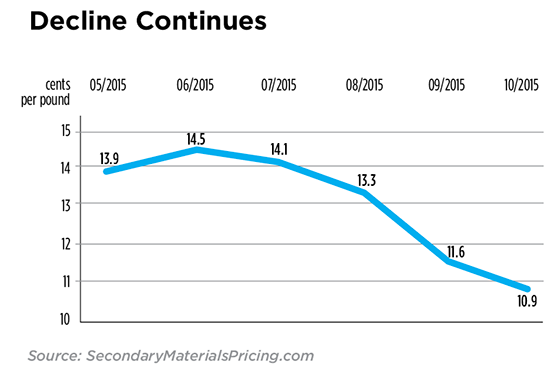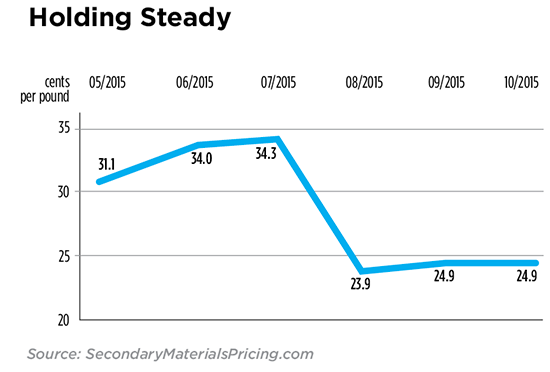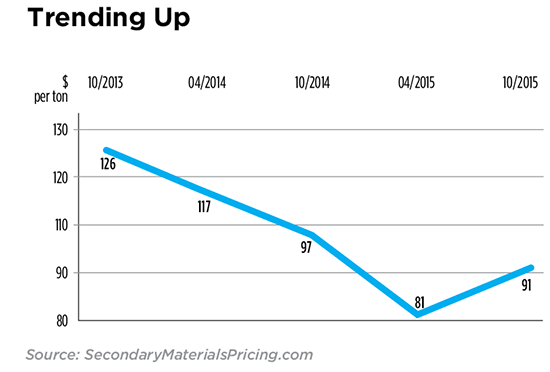In the latest readings, national average prices fell on post-consumer polyethylene terephthalate beverage bottles, remained flat on post-consumer natural high-density polyethylene and rose for post-consumer old corrugated cardboard.
Post-Consumer PET Prices Continue to Drop
In May 2015, the national average price of post-consumer polyethylene terephthalate (PET) beverage bottles and jars was reported at 13.9 cents per pound. One month later, the price had risen 4 percent to 14.5 cents per pound.
During the past three months, the national average price had dropped 25 percent to 11.6 cents per pound at the end of September.
Effective October 5, the market experienced another 6-percent drop, sitting at 10.9 cents per pound (see graph).
Currently, several materials recycling facilities managers are reporting low offers paid to them in the 5-6 cents per pound range, nearing the industry lows of 4.13 cents per pound, reported in April 2008.
These prices are as reported on the Secondary Materials Pricing (SMP) Index. This pricing represents what is being paid for post-consumer recyclable plastic materials in a sorted, baled format, picked up at most major recycling centers.

Source: www.secondarymaterialspricing.com
Post-Consumer Natural HDPE Prices Move Up Slightly
During the last six months, the national average price of post-consumer natural high-density polyethylene (HDPE) from curbside collection programs experienced a rise of 10 percent, from 31.1 cents per pound in May 2015 to 34.3 cents per pound in July 2015.
Moreover, in August 2015, the national average price took a dramatic 30-percent drop of 10.4 cents per pound. During the past month the national average price moved upward slightly by 4 percent, to the current level of 24.9 cents per pound (see graph). Historically, the national average price for this grade was 52.7 cents per pound in September 2014.
These prices are as reported on the Secondary Materials Pricing (SMP) Index. This pricing represents what is being paid for post-consumer recyclable plastic materials in a sorted, baled format, picked up at most major recycling centers.

Source: www.secondarymaterialspricing.com
Corrugated Prices
During the 18-month period running May 2013 to April 2015, the national average price of post-consumer old corrugated cardboard (PS-11) dropped gradually by 36 percent, from $126 per ton to $81 per ton (see graph).
During the past six months, the national average price has risen $10 per ton to the current national average level of $91 per ton.
By comparison, the national average price for clean new double-lined corrugated (PS-13) is $102 per ton.
These published prices are for post-consumer mill-size bales, FOB (freight on board) dealers’ plants, as reported on the Secondary Materials Pricing (SMP) Index.

Source: www.secondaryfiberpricing.com
Robert Boulanger is currently president of Recycling Markets Limited, and director of the Commodity Pricing division. He has extensive experience in the operation and management of recycling plants, and is a long-time publisher in the recycling sector.
About the Author(s)
You May Also Like


